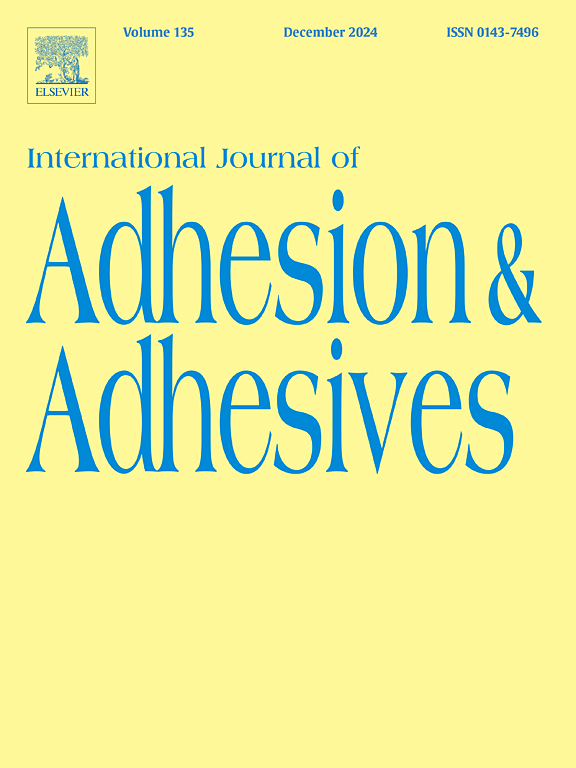无双酚A牙科粘合剂的多功能树突:G-IEMA的聚合行为和细胞毒性谱
IF 3.5
3区 材料科学
Q2 ENGINEERING, CHEMICAL
International Journal of Adhesion and Adhesives
Pub Date : 2025-09-23
DOI:10.1016/j.ijadhadh.2025.104162
引用次数: 0
摘要
确定在通用粘合剂中用Bis-GMA取代树突状大分子G-IEMA是否会改变实时固化/固化后性能和体外细胞毒性。五种纯单体(Bis-GMA, G-IEMA, UDMA, TEGDMA, HEMA)和四种粘合剂,两种商业对照(Scotchbond Universal, Futurabond M+)和两种仅在基础单体(EXP-BIS vs. EXP-G)上不同的实验配方,分别使用25%的Bis-GMA或G-IEMA,通过实时ATR-FTIR监测固化20分钟/固化后的聚合动力学(n = 3)。关键输出为最终转化率(DCmax)、最大聚合速率(Rpmax)和半反应时间(t0.5)。采用聚合和非聚合标本(n = 12)的提取物,通过24 h MTT和碘化丙酸(PI)测定来评估原代人牙髓细胞的细胞相容性。在均聚物中,DCmax无差异(单因素方差分析,p = 0.24),而Rp,max有差异(p < 0.0001), G-IEMA和TEGDMA比Bis-GMA更快;T0.5相似(p = 0.15)。不同粘接剂的DCmax (p = 0.06)、Rpmax (p = 0.89)和t0.5 (p = 0.27)具有可比性;EXP-GI达到最高DCmax(≈89%)。在两项检测中,G-IEMA的细胞毒性都低于Bis-GMA:在非聚合提取物和聚合提取物中,MTT分别为+ 20%和+ 51%;PI为- 40%和- 54% (p < 0.01)。对于黏合剂提取物,MTT显示了黏合剂的主要作用(双向方差分析,p < 0.001),但没有治疗效应/相互作用;相对于Scotchbond, EXP-GI支持+ 6.7%(非聚合)和+ 18.2%的代谢活性,而所有粘合剂保持低于对照组(p < 0.001)。聚合后EXP-GI的细胞凋亡比Scotchbond低17% (p = 0.049),比Futurabond低11% (p < 0.05)。G-IEMA可以取代Bis-GMA,而不会影响治疗效率或增加急性细胞毒性,支持其在不含bpa的通用粘合剂中的使用。本文章由计算机程序翻译,如有差异,请以英文原文为准。
A multifunctional dendrimer for BPA-free dental adhesives: Polymerization behavior and cytotoxic profile of G-IEMA
To determine whether substituting Bis-GMA for dendritic macromer G-IEMA in a universal adhesive alters real-time cure/post-cure performance and in-vitro cytotoxicity. Polymerization kinetics of five neat monomers (Bis-GMA, G-IEMA, UDMA, TEGDMA, HEMA) and four adhesives, two commercial controls (Scotchbond Universal, Futurabond M+) and two experimental formulations differing only in the base monomer, EXP-BIS vs. EXP-G, with 25 wt% of Bis-GMA or G-IEMA, respectively, were monitored by real-time ATR-FTIR for 20 min cure/post-cure (n = 3). Key outputs were final degree of conversion (DCmax), maximum polymerization rate (Rpmax) and half-time (t0.5). Cytocompatibility was assessed on primary human dental-pulp cells via 24 h MTT and propidium-iodide (PI) assays using extracts of polymerized and non-polymerized specimens (n = 12). Among homopolymers, DCmax did not differ (one-way ANOVA, p = 0.24) while Rp,max did (p < 0.0001), with G-IEMA and TEGDMA faster than Bis-GMA; t0.5 was similar (p = 0.15). Across adhesives, DCmax (p = 0.06), Rpmax (p = 0.89) and t0.5 (p = 0.27) were comparable; EXP-GI reached the highest DCmax (≈89 %). G-IEMA was less cytotoxic than Bis-GMA in both assays: MTT +20 % and +51 % in non-polymerized and polymerized extracts, respectively; PI −40 % and −54 % (all pairwise p < 0.01). For adhesive extracts, MTT showed a main effect of adhesive (two-way ANOVA, p < 0.001) but no treatment effect/interaction; relative to Scotchbond, EXP-GI supported +6.7 % (non-polymerized) and +18.2 % higher metabolic activity, while all adhesives remained below the control (p < 0.001). After polymerization, EXP-GI exhibited 17 % lower apoptosis than Scotchbond (p = 0.049) and 11 % lower than Futurabond (p < 0.05). G-IEMA can replace Bis-GMA without compromising cure efficiency or increasing acute cytotoxicity, supporting its use in BPA-free universal adhesives.
求助全文
通过发布文献求助,成功后即可免费获取论文全文。
去求助
来源期刊

International Journal of Adhesion and Adhesives
工程技术-材料科学:综合
CiteScore
6.90
自引率
8.80%
发文量
200
审稿时长
8.3 months
期刊介绍:
The International Journal of Adhesion and Adhesives draws together the many aspects of the science and technology of adhesive materials, from fundamental research and development work to industrial applications. Subject areas covered include: interfacial interactions, surface chemistry, methods of testing, accumulation of test data on physical and mechanical properties, environmental effects, new adhesive materials, sealants, design of bonded joints, and manufacturing technology.
 求助内容:
求助内容: 应助结果提醒方式:
应助结果提醒方式:


